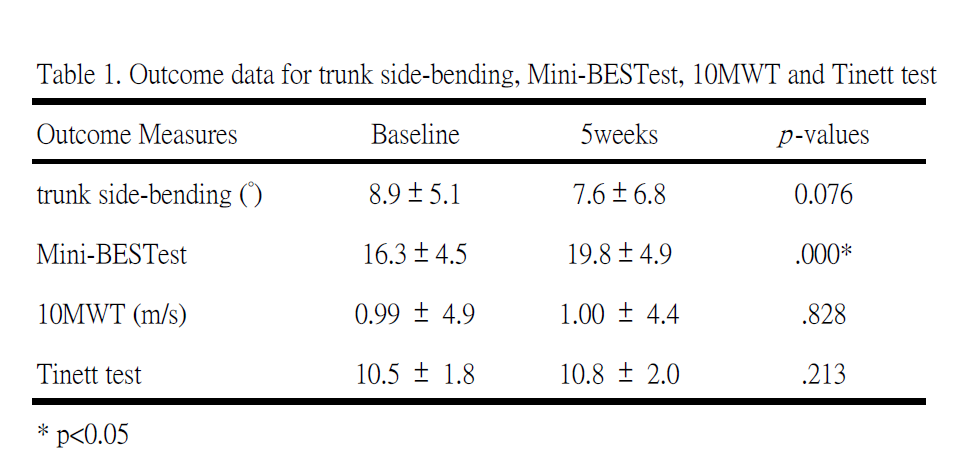Objective: To investigate the effect of core muscle exercise training on posture, balance, walking speed and walking quality in Parkinson’s disease (PD) patients with trunk side-bending (SB) and the correlation between the baseline trunk SB angle and balance ability, walking speed and walking quality.
Background: Trunk SB is a common problem for patients with PD. This postural abnormality may be the cause of problems regarding balance, walking speed and walking quality. It has been shown in previous studies that exercise interventions can improve balance and walking quality. There is insufficient evidence on the efficacy of core muscle exercise training in Parkinson’s disease with trunk SB.
Method: Twenty-four PD patients (70.1±7.8 years old) with a trunk SB angle ≥ 5 degrees and Hoehn & Yahr stage II or III were included in this study and underwent a 50-minute group exercise intervention twice a week for five weeks, consisting of 25 minutes of core muscle exercises on the mat and 25 minutes of dynamic movement training. Trunk SB, balance, walking speed and walking quality were assessed before and after exercise by measuring the side bending angle, the Mini Balance Evaluation Systems Test (Mini-BESTest), the 10-Meter Walk Test (10MWT) and the Tinetti test. Mini-BESTest includes four subcomponents: anticipatory, reactive postural control, sensory orientation, dynamic gait. Pearson correlation was used to analyze the correlation between trunk SB and balance, walking speed and walking quality. A paired t-test was used to compare pre and post training difference.
Results: When comparing pre- and post- training results, a significant difference was found in the Mini-BESTest (p=.00002) [table1]. However, there was no significant difference in the angle of postural SB after core muscle exercise training, although there was a trend of improvement. (p=.076). There was a negative correlation between the baseline trunk SB angle and the sensory orientation of the Mini-BESTest (r=-.489, p=.015). However, no significant correlation was found between SB angle and walking speed and walking quality changes before and after training.
Conclusion: Core muscle exercise interventions can improve balance in PD patients and also have a tendency to improve postural tilt. There is a correlation between the trunk SB angle and the sensory orientation of balance in patients with PD.
References: Artusi, C. A., Montanaro, E., Erro, R., Margraf, N., Geroin, C., Pilotto, A., . . . Lopiano, L. (2023). Visuospatial Deficits Are Associated with Pisa Syndrome and not Camptocormia in Parkinson’s Disease. Mov Disord Clin Pract, 10(1), 64-73. doi:10.1002/mdc3.13605
Etoom, M., Alwardat, M., Aburub, A. S., Lena, F., Fabbrizo, R., Modugno, N., & Centonze, D. (2020). Therapeutic interventions for Pisa syndrome in idiopathic Parkinson’s disease. A Scoping Systematic Review. Clin Neurol Neurosurg, 198, 106242. doi:10.1016/j.clineuro.2020.106242
To cite this abstract in AMA style:
JC. Hsu, YC. Chein, KH. Chen, HY. Chen, HT. Tsai, YH. Chen. Effectiveness of core muscle exercise training for Parkinson’s disease patients with trunk side-bending [abstract]. Mov Disord. 2023; 38 (suppl 1). https://www.mdsabstracts.org/abstract/effectiveness-of-core-muscle-exercise-training-for-parkinsons-disease-patients-with-trunk-side-bending/. Accessed December 29, 2025.« Back to 2023 International Congress
MDS Abstracts - https://www.mdsabstracts.org/abstract/effectiveness-of-core-muscle-exercise-training-for-parkinsons-disease-patients-with-trunk-side-bending/

